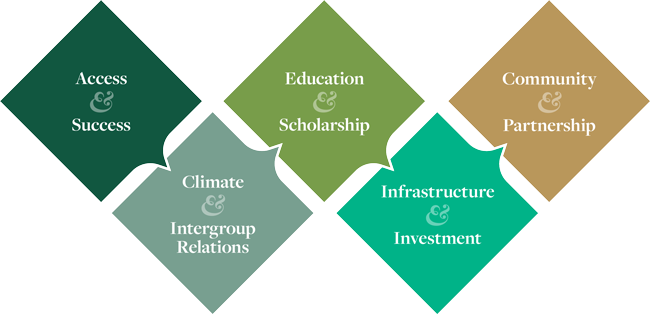Inclusive Excellence
Inclusive Excellence is a framework designed to integrate diversity, equity and inclusion efforts. As a model, it incorporates diversity efforts into the core of organizational functioning. Applying Inclusive Excellence concepts leads to infusing diversity into an organization's recruiting and hiring processes, into its training, and into its administrative structures and practices. Inclusive Excellence means an organization has adopted means for the cohesive, coherent and collaborative integration of diversity, inclusion and equity into the organizational pursuit of excellence.
Accepting the Inclusive Excellence model reflects the understanding that diversity, equity and inclusion lead to organizational excellence and are to be invited and integrated into the very core of the business enterprise and are not isolated initiatives. This framework moves efforts from the margins as a moral imperative to an interwoven space where what is measured gets done. It also creates a shared narrative across the university, from academics to procurement.
2023-2026 inclusive Excellence Framework (PDF)
Definitions
The Inclusive Excellence framework provides specific definitions for the terms diversity, equity and inclusion.
DiversityThe term diversity is used to describe the various mix or combinations of human differences (e.g., personality, learning styles and life experiences) and group/social differences (e.g., race/ethnicity, class, gender/gender identity, sexual orientation, country of origin and ability as well as cultural, political, religious or other affiliations) that can be engaged in the service of learning and working together. |
EquityThe creation of opportunities for historically underrepresented populations to have equal access and equitable opportunity to and participate in educational programs designed to reduce the academic/opportunity gap in student success and completion. Equity is also the process of allocating resources, programs and opportunities to staff, faculty and students without historical discrimination and addressing imbalances. |
InclusionThe term inclusion is used to describe the active, intentional and ongoing engagement with diversity – in people, in the curriculum, in the co-curriculum and in communities (intellectual, social, cultural, geographical) with which individuals might connect – in ways that increase one's awareness, content knowledge, cognitive sophistication and emphatic understanding of the complex ways individuals interact with and within systems and institutions. |
Dimensions of the Inclusive Excellence Framework
Each dimension of the model represents an area where diversity, equity and inclusion (DEI) initiatives are designed to achieve social, academic, professional and institutional excellence.

Access + Success
Pipeline into the university (recruitment and retention of faculty, staff and students)
Climate + Intergroup Relations
Climate - how members of the community feel about their work environment
Education + Scholarship
Curriculum and research - the core of the university's mission
Infrastructure + Investment
Structure, accountability
Community + Partnership
Innovation, partnerships
The guiding principle of Making Excellence Inclusive was created by the Association of American Colleges & Universities in 2005. Read the AACU article on Making Diversity Work on Campus (pdf).














